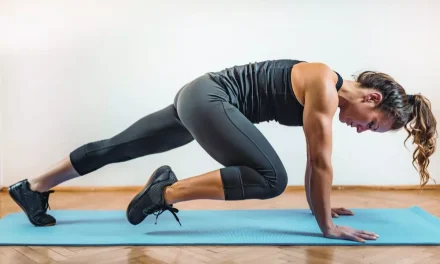In this article:
The first rule for working out safely and efficiently: know what you are doing! (not like the one in the picture above…)
When it comes to fitness, it’s easy to get caught up in the pursuit of extreme results. However, a sustainable and effective workout routine goes beyond just chasing performance gains.
A holistic approach considers not only strength and endurance but also flexibility, aerobic efficiency, and overall functionality.
Let’s delve into the key components of a well-rounded fitness plan.
1. Aerobic Activity

Copyright Sri Maiava Rusden/Taxi/Getty Images
Aerobic exercises, such as running, cycling, or swimming, elevate your heart rate and improve cardiovascular health. Regular aerobic workouts enhance endurance, boost energy levels, and even contribute to better sleep. Aim for at least 150 minutes of moderate-intensity aerobic activity per week, or 75 at high intensity.
Any combination will do.
For example:
– day 1: 30 mins at low intensity
– day 2: 20 mins at high intensity
– day 3: 30 mins at low intensity
– day 4: 30 mins at low intensity
– day 5: 30 mins at low intensity
2. Strength Training

Strength training is essential for building and maintaining muscle, especially after the age of 30. As we age, we inevitably experience muscle loss at a rate of almost 3-8% every decade. Additionally, strength training contributes to maintaining bone density and overall functionality. Consider incorporating resistance exercises such as weightlifting, bodyweight movements, or resistance bands. Focus on major muscle groups and gradually increase the load to challenge your body. For optimal results, follow these guidelines:
- Target All Major Muscle Groups: Aim to work each major muscle group at least 2 times a week (but 1 time a week might be enough, especially for younger people).
- Series and Repetitions: Aim for 6-8 sets per week for each muscle group, stopping 1 or 2 repetitions before failure. Usually, you should adjust the weights in order to reach failure in less than 6 repetitions when training for power, more than 12 repetitions when training for resistance, and around 10 repetitions for general purposes.
- Concentric Phase: When pushing during the concentric phase (e.g., pull-ups), start from a stretched position. For instance, let your body hang down in a completely relaxed state before pushing yourself up again.
- Eccentric Phase: During the eccentric phase (e.g., pull-ups), deliberately slow down the descent, taking at least 3 seconds to complete the movement until your arms are fully extended.
- While it’s technically possible to train practically your entire body in one session using just 3 exercises (such as chest press, rows, and leg press), don’t neglect weaker muscles and those less involved in compound exercises. These include the hip adductors, deltoids, shoulder rotator cuffs, calves, and the muscles responsible for extending your foot and lifting it toward the knee. Additionally, pay attention to the core and the muscles involved in rotating and twisting the body. More details on functional training can be found in the relevant section.
3. Flexibility and Stretching

Don’t neglect flexibility! Stretching helps prevent injuries, improves joint mobility, and enhances muscle elasticity. Incorporate dynamic stretches before your workout and static stretches afterward. Yoga and Pilates are excellent options for promoting flexibility and balance. Here’s my suggestion:
 Visit a physiotherapist or a posture expert regularly. They will provide personalized exercise recommendations based on:
Visit a physiotherapist or a posture expert regularly. They will provide personalized exercise recommendations based on:
- Your Current Level
- Your Posture Problems
- Your Imbalances
4. Functional training

Lunges are among the best functional exercises to keep you fit and functional at any age.
Remember: unless you’re a powerlifter, you do not train to improve your deadlifts. Similarly, unless you’re a marathon runner, you do not train to improve your times. While improving or maintaining performance is crucial to understanding if your workout routine is yielding results, what you are truly training for is FUNCTIONALITY. This means being able to do what you enjoy in the way you prefer.
For instance, if you’re a grandfather who has just welcomed a new nephew, you might want to carry him on your shoulders for a long walk or play football together. If gardening is your passion, you’ll want to crouch down and lift weights throughout the day without suffering from back pain for the next two days. And you’d like to maintain this ability not only in your 40s but also into your 80s or 90s because it brings you joy. Do you see my point?
Focusing solely on isolating your biceps or chest during training is unlikely to keep you functional throughout your life. For every complex movement, such as standing on one leg or brushing your teeth, you need special muscle-brain connections. These connections can fade if you neglect them. Therefore, train for FUNCTIONALITY by incorporating exercises that involve:
- Balance
- Proprioception
- Lateral Movements
- Twisting
- Hanging (possibly lifting your legs or doing pull-ups)
- Lifting weights from the ground while maintaining proper back posture
- Getting up from a sitting or lying-down position without using your hands
Performing these movements is KEY to maintaining functionality at any age.
5. Recovery

We have a finite capacity for recovery in our bodies. For instance, after performing a series of sprints, our body needs to recover from various factors:
- Muscle Damage
- Lactic Acid Buildup
- Depletion of Glycogen and Creatine Reserves
- Depletion of the Enzymatic System
- Depletion of the Immune System
- Reduction of Inflammation Markers in the Body
- Recovery from Muscle Acidification
The intensity and the number of muscles trained impact the recovery time. Higher intensity and more muscle groups involved require longer recovery periods. However, it’s essential to note that you don’t need to be fully recovered to train again; you only need to be recovered in the specific areas utilized during the workout. For example, if you had a strength training session for your shoulders and arms yesterday, today you can engage in high-intensity interval training with sprints. Low-intensity exercises (those that don’t significantly elevate heart rate) are less demanding on the enzymatic, immune systems (and, indirectly, the digestive system), while sprints don’t strain the upper body muscles heavily.
For example, athletes are well aware that low-intensity training improves the quality of sleep at night, while high-intensity workouts tend to have the opposite effect. This phenomenon occurs because, after a high-intensity training session, hormones and chemicals that keep us alert also increase our metabolic rate and, consequently, our body temperature. These effects persist for a longer duration and with greater intensity than for low-intensity trainings.
Additionally, consider that smaller muscles recover more quickly. Hand grip muscles or deltoids may need just one day (or even less) to recover, whereas after training the legs, it’s advisable to rest for approximately 48 hours. This variation is due to the fixed amount of recovery our bodies perform each day, whether it’s directed toward small muscles, the enzymatic system, or the entire body.
6. Avoiding Injuries

How to perform a skater. Image by Jay Sullivan
You have three ways to avoid injuries:
- Perform Exercises with Proper Form and Warm Up Well: Ensuring correct form during exercises and a thorough warm-up are essential. A basic warm-up routine involves:
- Increasing Your Heart Rate: This prepares your body to sustain effort for a longer duration.
- Performing the Same Exercise You’ll Do During the Session: However, do it at a lower intensity. Additionally, stretch your muscles well and use lighter weights.
- Cross-Train to Prevent Overuse Injuries: Give specific muscle groups time to recover by incorporating cross-training. For instance, if you’re a runner, consider cycling or using ellipticals once a week. Even walking can be beneficial.
- Build Muscle Power for Both Concentric and Eccentric Phases: Strengthen not only for endurance and resistance but also for explosive power. Consider exercises like:
- Plyometric Jumps (advanced level)
- Alternate Jumping Lunges (advanced level)
- Knee Jumps (advanced level)
- Slam Ball Throws (medium level)
- Skaters (medium level)
- Jumping Squats (medium level)
- Any Strength Exercise Performed at 100% of Maximum Speed (basic level)
Takeaway
Remember: Seeking advice from a professional is never a bad idea. You’re investing time and energy in your attempt to improve your fitness level, so always make well-informed choices. This will help you get the most out of your workouts in the short, medium, and long term, while minimizing the risk of injuries or future posture problems.
For more tips on maintaining health and youthfulness at any age, explore our comprehensive article:
The 10 most efficient, scientifically proven habits to stay young and fit at any age
References:
- Mersy DJ. Health benefits of aerobic exercise. Postgrad Med. 1991 Jul;90(1):103-7, 110-2. doi: 10.1080/00325481.1991.11700983. PMID: 2062750.
- Westcott WL. Resistance training is medicine: effects of strength training on health. Curr Sports Med Rep. 2012 Jul-Aug;11(4):209-16. doi: 10.1249/JSR.0b013e31825dabb8. PMID: 22777332.
- Androulakis-Korakakis P, Fisher JP, Steele J. The Minimum Effective Training Dose Required to Increase 1RM Strength in Resistance-Trained Men: A Systematic Review and Meta-Analysis. Sports Med. 2020 Apr;50(4):751-765. doi: 10.1007/s40279-019-01236-0. PMID: 31797219.
- Spiering BA, Mujika I, Sharp MA, Foulis SA. Maintaining Physical Performance: The Minimal Dose of Exercise Needed to Preserve Endurance and Strength Over Time. J Strength Cond Res. 2021 May 1;35(5):1449-1458. doi: 10.1519/JSC.0000000000003964. PMID: 33629972.
- Xiao W, Soh KG, Wazir MRWN, Talib O, Bai X, Bu T, Sun H, Popovic S, Masanovic B, Gardasevic J. Effect of Functional Training on Physical Fitness Among Athletes: A Systematic Review. Front Physiol. 2021 Sep 6;12:738878. doi: 10.3389/fphys.2021.738878. PMID: 34552511; PMCID: PMC8450457.
- Fabio Comana. Exploring the science of recovery. https://blog.nasm.org/the-science-of-recovery
- Bishop, P.A., Jones, E., & Woods, A.K. 2008. Recovery from training: a brief review. Journal of Strength and Conditioning Research, 22 (3), 1015–1024.
Disclaimer
Consult a health professional before making significant changes to your diet, exercise routine, or supplement regimen. The information provided in this blog is intended to convey the latest scientific research in an accessible manner. However, it does not replace the advice of a medical professional. Take your health conditions into account and consult a qualified healthcare provider to ensure that the decisions you make are safe and appropriate for your specific health needs. Ultimately, you are responsible for your own health and well-being.






Your blog is a breath of fresh air in the often stagnant world of online content. Your thoughtful analysis and insightful commentary never fail to leave a lasting impression. Thank you for sharing your wisdom with us.